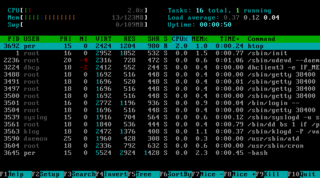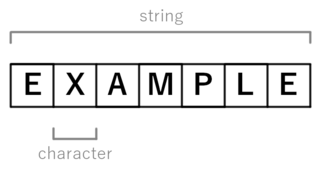Related Research Articles
In computing and telecommunications, a control character or non-printing character (NPC) is a code point in a character set that does not represent a written character or symbol. They are used as in-band signaling to cause effects other than the addition of a symbol to the text. All other characters are mainly graphic characters, also known as printing characters, except perhaps for "space" characters. In the ASCII standard there are 33 control characters, such as code 7, BEL, which rings a terminal bell.

Digital data, in information theory and information systems, is information represented as a string of discrete symbols, each of which can take on one of only a finite number of values from some alphabet, such as letters or digits. An example is a text document, which consists of a string of alphanumeric characters. The most common form of digital data in modern information systems is binary data, which is represented by a string of binary digits (bits) each of which can have one of two values, either 0 or 1.
In digital transmission, the number of bit errors is the number of received bits of a data stream over a communication channel that have been altered due to noise, interference, distortion or bit synchronization errors.
A communications system or communication system is a collection of individual telecommunications networks systems, relay stations, tributary stations, and terminal equipment usually capable of interconnection and interoperation to form an integrated whole. The components of a communications system serve a common purpose, are technically compatible, use common procedures, respond to controls, and operate in union.
In telecommunications, an End-of-Transmission character (EOT) is a transmission control character. Its intended use is to indicate the conclusion of a transmission that may have included one or more texts and any associated message headings.
In computing and telecommunications, an escape character is a character that invokes an alternative interpretation on the following characters in a character sequence. An escape character is a particular case of metacharacters. Generally, the judgement of whether something is an escape character or not depends on the context.

ANSI escape sequences are a standard for in-band signaling to control cursor location, color, font styling, and other options on video text terminals and terminal emulators. Certain sequences of bytes, most starting with an ASCII escape character and a bracket character, are embedded into text. The terminal interprets these sequences as commands, rather than text to display verbatim.

In computing and telecommunications, a character is a unit of information that roughly corresponds to a grapheme, grapheme-like unit, or symbol, such as in an alphabet or syllabary in the written form of a natural language.

A universal asynchronous receiver-transmitter is a peripheral device for asynchronous serial communication in which the data format and transmission speeds are configurable. It sends data bits one by one, from the least significant to the most significant, framed by start and stop bits so that precise timing is handled by the communication channel. The electric signaling levels are handled by a driver circuit external to the UART. Common signal levels are RS-232, RS-485, and raw TTL for short debugging links. Early teletypewriters used current loops.

A communication channel refers either to a physical transmission medium such as a wire, or to a logical connection over a multiplexed medium such as a radio channel in telecommunications and computer networking. A channel is used for information transfer of, for example, a digital bit stream, from one or several senders to one or several receivers. A channel has a certain capacity for transmitting information, often measured by its bandwidth in Hz or its data rate in bits per second.

A computer terminal is an electronic or electromechanical hardware device that can be used for entering data into, and transcribing data from, a computer or a computing system. Most early computers only had a front panel to input or display bits and had to be connected to a terminal to print or input text through a keyboard. Teleprinters were used as early-day hard-copy terminals and predated the use of a computer screen by decades. The computer would typically transmit a line of data which would be printed on paper, and accept a line of data from a keyboard over a serial or other interface. Starting in the mid-1970s with microcomputers such as the Sphere 1, Sol-20, and Apple I, display circuitry and keyboards began to be integrated into personal and workstation computer systems, with the computer handling character generation and outputting to a CRT display such as a computer monitor or, sometimes, a consumer TV, but most larger computers continued to require terminals.
Synchronous Data Link Control (SDLC) is a computer serial communications protocol first introduced by IBM as part of its Systems Network Architecture (SNA). SDLC is used as layer 2, the data link layer, in the SNA protocol stack. It supports multipoint links as well as error correction. It also runs under the assumption that an SNA header is present after the SDLC header. SDLC was mainly used by IBM mainframe and midrange systems; however, implementations exist on many platforms from many vendors. In the United States and Canada, SDLC can be found in traffic control cabinets. SDLC was released in 1975, based on work done for IBM in the early 1970s.
In telecommunications, in-band signaling is the sending of control information within the same band or channel used for data such as voice or video. This is in contrast to out-of-band signaling which is sent over a different channel, or even over a separate network. In-band signals may often be heard by telephony participants, while out-of-band signals are inaccessible to the user. The term is also used more generally, for example of computer data files that include both literal data, and metadata and/or instructions for how to process the literal data.

EIA-608, also known as "Line 21 captions" and "CEA-608", is a standard for closed captioning for NTSC TV broadcasts in the United States, Canada and Mexico. It was developed by the Electronic Industries Alliance and required by law to be implemented in most television receivers made in the United States.
In data communications, flow control is the process of managing the rate of data transmission between two nodes to prevent a fast sender from overwhelming a slow receiver. Flow control should be distinguished from congestion control, which is used for controlling the flow of data when congestion has actually occurred. Flow control mechanisms can be classified by whether or not the receiving node sends feedback to the sending node.
A binary-to-text encoding is encoding of data in plain text. More precisely, it is an encoding of binary data in a sequence of printable characters. These encodings are necessary for transmission of data when the communication channel does not allow binary data or is not 8-bit clean. PGP documentation uses the term "ASCII armor" for binary-to-text encoding when referring to Base64.
The Apple Icon Image format (.icns) is an icon format used in Apple Inc.'s macOS. It supports icons of 16 × 16, 32 × 32, 48 × 48, 128 × 128, 256 × 256, 512 × 512 points at 1x and 2x scale, with both 1- and 8-bit alpha channels and multiple image states. The fixed-size icons can be scaled by the operating system and displayed at any intermediate size.
Polling, or interrogation, refers to actively sampling the status of an external device by a client program as a synchronous activity. Polling is most often used in terms of input/output, and is also referred to as polled I/O or software-driven I/O. A good example of hardware implementation is a watchdog timer.
Single-carrier FDMA (SC-FDMA) is a frequency-division multiple access scheme. Originally known as Carrier Interferometry, it is also called linearly precoded OFDMA (LP-OFDMA). Like other multiple access schemes, it deals with the assignment of multiple users to a shared communication resource. SC-FDMA can be interpreted as a linearly precoded OFDMA scheme, in the sense that it has an additional DFT processing step preceding the conventional OFDMA processing.

Information is an abstract concept that refers to something which has the power to inform. At the most fundamental level, it pertains to the interpretation of that which may be sensed, or their abstractions. Any natural process that is not completely random and any observable pattern in any medium can be said to convey some amount of information. Whereas digital signals and other data use discrete signs to convey information, other phenomena and artifacts such as analogue signals, poems, pictures, music or other sounds, and currents convey information in a more continuous form. Information is not knowledge itself, but the meaning that may be derived from a representation through interpretation.
References
- ↑
 This article incorporates public domain material from Federal Standard 1037C. General Services Administration. Archived from the original on 22 January 2022. (in support of MIL-STD-188).
This article incorporates public domain material from Federal Standard 1037C. General Services Administration. Archived from the original on 22 January 2022. (in support of MIL-STD-188). - ↑
 This article incorporates public domain material from Dictionary of Military and Associated Terms . United States Department of Defense.
This article incorporates public domain material from Dictionary of Military and Associated Terms . United States Department of Defense. - ↑ "Configuring Netscape Mail on Unix: Solaris and Content-Length". Archived from the original on 8 April 2009. Retrieved 9 April 2009.